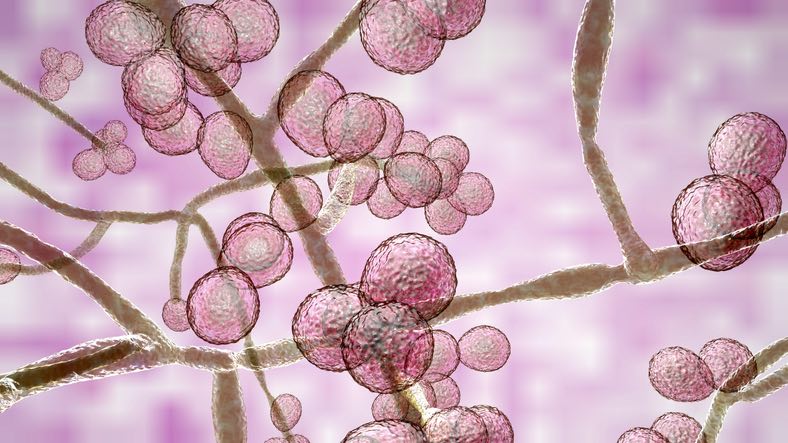What to Do About Oral Thrush in Babies

For some, feeding an infant can be a time that’s filled with quality bonding and cozy snuggles. Some mothers may feel the world melt away as the connection with their little one deepens. It’s challenging for any mother when medical factors get in the way of this experience. If you’ve noticed your baby pulling away from your chosen feeding method or being unusually fussy, you might want to make sure oral thrush isn’t the culprit.
What is Oral Thrush in Babies?

According to the Mayo Clinic, oral thrush (also called oral candidiasis) is a condition in which the fungus known as Candida albicans accumulates on the lining of the mouth. While candida normally lives on your skin and on your body in places like your mouth, certain factors can cause candida to overgrow. About 1 in 7 babies develop oral thrush and it’s more common in newborns under 10 weeks old.
What Causes Oral Thrush in Babies?
There are several reasons oral thrush can take over your little one’s smile. Candida is a fungal infection caused by yeast, and yeast thrives in warm, moist, places. So, this means your baby’s mouth (whether breast or bottle-fed) is the perfect environment for an infection like this to thrive. It occurs more frequently in babies because of their reduced immunity and can be made worse by the friction of sucking. Another cause for this infection could be due to the baby (or breastfeeding mother) taking antibiotics because the antibiotic “kills off” the good bacteria.
What Does Oral Thrush in Babies Look Like?
The white cottage cheese-like spots in your infant’s mouth are a tell-tale sign of oral thrush. You’ll see these lesions on the inside of your baby’s cheeks, gums, tongue, and
sometimes on the roof of their mouth. Along with these smallish white spots, there can be redness that occurs. If you’re nursing, it’s good to note that this infection may be passed from baby to breastfeeding parent. The Mayo Clinic suggests that nursing mothers should be on the lookout for symptoms such as unusually red, sensitive, or cracked nipples, pain in the breast during feedings, and sharp pains within the breast.
What are the Side Effects and Other Signs of Oral Thrush?

The white spots that occur in oral thrush can’t be rubbed off. The spots are different from milk crude which can be easily cleaned. Other symptoms to watch out for are crying when feeding and diaper rash.
When trying to figure out if your baby is dealing with a bout of oral thrush, there are several other symptoms that can give you clues. Seattle Children’s Hospital suggests looking for these signs in your baby’s behavior:
- pulling away from the bottle or your breast during feeding time
- decreased sucking and/or milk intake
- fussy when eating.
If one or all of these signs gets checked off your list, checking in with your pediatrician can answer any questions you might have about the possibility of oral thrush. They can make a formal diagnosis.
Is Oral Thrush in Babies Serious?
Oral thrush in babies is usually harmless. In some cases, your baby’s thrush will disappear on its own, but in more severe cases talking to your pediatrician about your next step is, well…the next step. Oral thrush can be easily treated with prescribed medications which might include an antifungal medication.
Is Oral Thrush Painful for Babies?
While those creamy white patches in your little one’s mouth may look uncomfortable, for many babies it only causes only mild discomfort. If your little one is behaving and eating normally, then it’s also possible your newborn isn’t noticing anything at all. But you know your baby, so if they appear to be having issues during your feeding sessions, the infection might’ve shifted to an uncomfortable or painful level. If you have any questions or concerns, book an appointment with your child’s pediatrician.
What is the Fastest Way to Treat Thrush in Babies?
It’s possible your little one’s oral thrush will go away on its own in a week or two. However, there are at-home remedies available such as taking a probiotic to help prevent the overgrowth of candida. But before trying any new treatment, be sure to speak with your doctor. Together, you might decide an over-the-counter medication is preferred.
How Long Does It Take for Oral Thrush in Babies to Go Away?
Each case of thrush is extraordinarily different. For some babies, oral thrush may magically disappear after a week, but for others, it may take a prescribed medication to speed up the process. If your pediatrician prescribes a medicine like an antifungal, the thrush could clear up in as little as 4 to 5 days.
How Can You Prevent Oral Thrush?
The good news is there are easy steps you can take to prevent oral thrush from recurring, or even making its first appearance. If you formula-feed your infant make sure to clean the nipples in hot water or a dishwasher after use. If you breastfeed, look out for the symptoms of nipple thrush (such as pain in the nipples and breasts after feeding, fever, and warm patches on your breast), to make sure you don’t pass the infection back and forth between you and your little one.
While oral thrush might initially look frightening, it’s in fact a common and easily treatable infection that will affect 5% of healthy newborns. Taking preventive measures can help keep that candida overgrowth from growing. But if oral thrush does show up for you and your little one, it’s good to know there are options out there that can provide quick relief for your little one, so you can go back to your quality feeding time snuggles once more.

